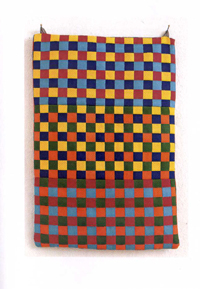1998

68 x 46 cms
| 2 zu 3 doppelt 1998 |
 |
|
| 68 x 46 cms |
"I like it when painting lies on the limit of what is not supposed to be painting any more" (Dubuffet. )
Extracts from the catalogue of "New Works by Ulrich Diekmann, Weaving, Sewing, Sanding" 1998.
Apparently, Ulrich Diekmann does something very simple. His pieces come into being by using some of the basic cultural techniques such as waving, sewing and sanding. Traditional crafts are linked with advanced artistic methods:- fluorescent colour is combined with jute, acrylic paint with paper, mechanical processes of weaving and grinding generate painting.
The principle of "upside down" dominates Ulrich Diekmann's acrylic paintings. The painting results from a process of sanding, grinding and polishing which makes the different coats of paint visible and forces them onto the same pictorial level. The solid sheets of paint bring to mind precious stones and geological formations but they are also reminiscent of marble and rocks. Paint and colour in these pieces are at the same time substance and material; it is raw, solid and massive.
The untreated sides of the painting expose the process of painting. In all pieces by Diekmann the edges and surfaces of the painting, its sides and borders are an important subject, which take the beholders changing viewpoint into account. Smooth surfaces contrast with fissured, pressed and torn edges, raising the question of whether the pieces should be seen as two dimensional objects or as sculptures/objects. Formally, all that is left to the artist are two specifically limited kinds of freedom: the choice of materials and the commitment to a desired format. The process of sanding in its repetitive pattern gives way to new creative forms;- the subjective brushstroke has been dropped.
Ulrich Diekmann doesn't only tie together threads and fabrics. He also joins formal severity and coincidence, surfaces and limits. He is commenting on the History of Art with wit and a dry sense of humour.